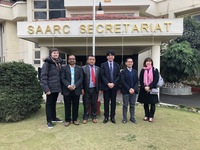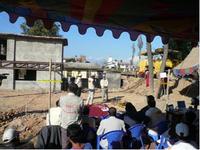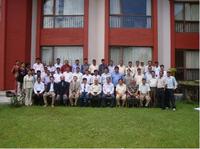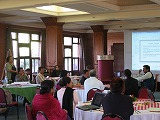25-29 February 2020 (Kathmandu, Nepal)

ADRC engaged in three different activities during the visit to Nepal. Firstly, ADRC Executive Director, along with researchers from JICA Tohoku Center and University of Hyogo, met with Mr. Sushil Gyewali, CEO of National Reconstruction Authority (NRA) and other officials. The meeting discussed the joint research project on Modeling Disaster Recovery Governance in Asia. Mr. Gyewali explained the process as well as the progress of recovery from the 2015 Gorkha Earthquake. He reported that as of December 2019, 85% of all projects were completed. During the field visits, the team learned that NRA utilizes 'User Committees' to reconstruct completely damaged heritage sites (e.g., Ranipokhari). NRA also promotes 'Integrated Settlements' in reconstructing private houses (e.g., Ward 12 in Melamchi). Since NRA will be dissolved in the end of 2020, its functions will be transferred to the National Disaster Risk Reduction and Management Authority (NDRRMA) - a newly established agency. Secondly, ADRC, in collaboration with experts from Asian Institute of Technology (AIT) and GeoThings, organized a workshop on the 'Utilization of ICT to Strengthen Disaster Resilience'. In this workshop, GeoThings demonstrated the functions of 'geoBingAn' - a social media Apps that functions to report personal safety and simple assessments (e.g., building damage) following a disaster. Thirdly, ADRC coordinated other separate meetings with SAARC Secretariat, NDRRMA, Planning Ministry, and JICA Nepal.
(2020/03/13 14:40)





 The annual meeting of the Asian Disaster Reduction and Response Network (ADRRN) 2008 was held in Kathmandu, Nepal on 3-5 November 2008. In the meeting, titled Learning through and from the Network, approximately 40 participants from NGOs and international organizations as well as the ADRC had active discussions in order to further reinforce the activities of their organizations and ADRRN toward DRR.
The annual meeting of the Asian Disaster Reduction and Response Network (ADRRN) 2008 was held in Kathmandu, Nepal on 3-5 November 2008. In the meeting, titled Learning through and from the Network, approximately 40 participants from NGOs and international organizations as well as the ADRC had active discussions in order to further reinforce the activities of their organizations and ADRRN toward DRR.